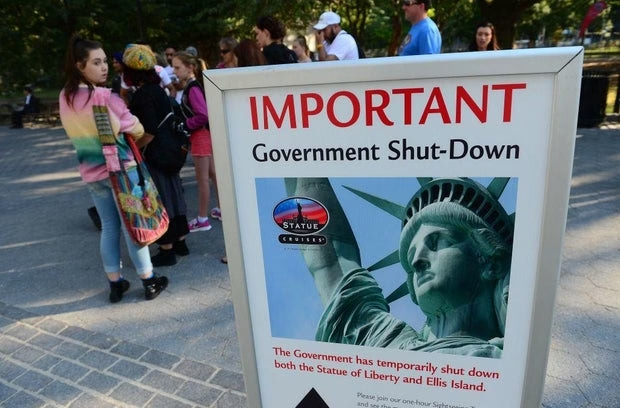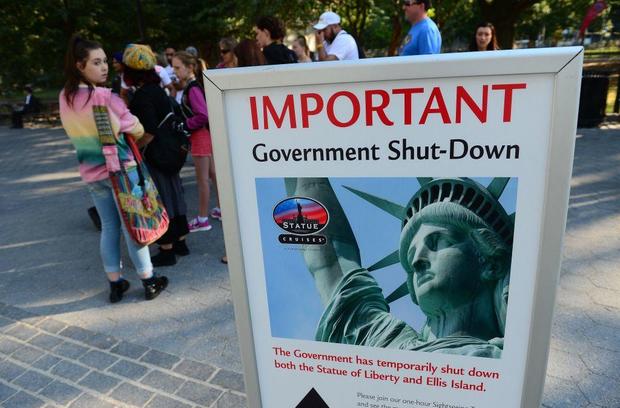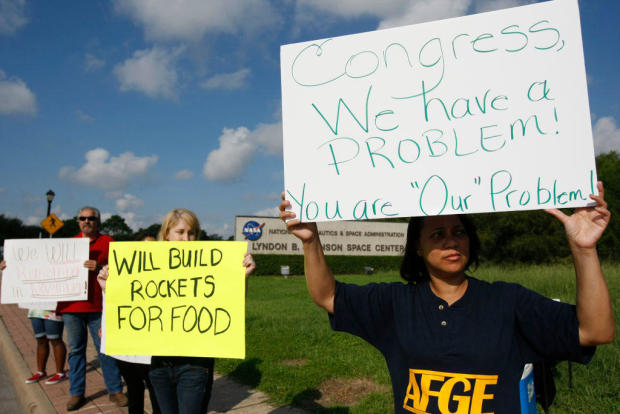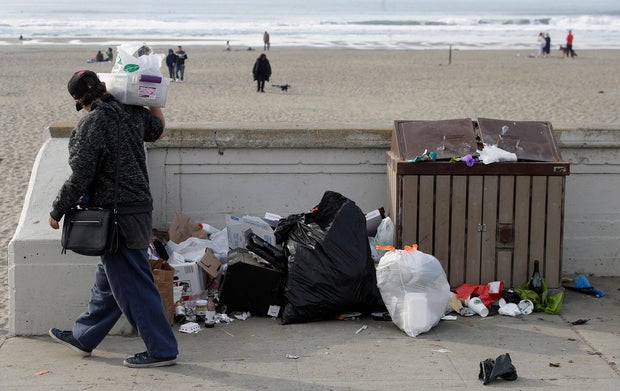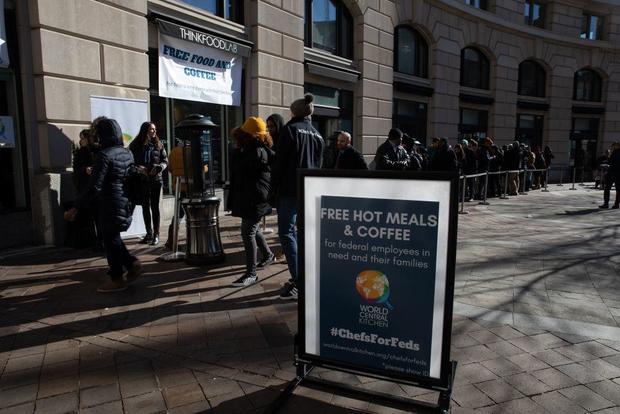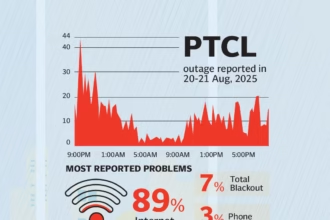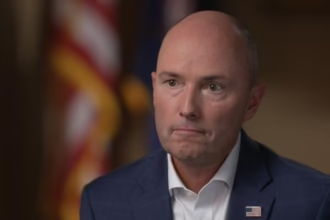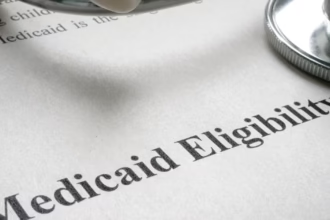Washington — Much of the federal government is on the verge of shutting down if Congress does not reach a deal to approve new funding by Wednesday, Oct. 1, 2025.
Republicans have proposed extending government funding at current levels until Nov. 21 to allow for members to continue working on full-year appropriations bills. Democrats made a counteroffer to keep the government open through October, but attached health care provisions and restrictions on President Trump’s ability to withhold funding, both of which are nonstarters with most Republicans.
The two sides are dug in on their positions, increasing the chances of a shutdown beginning Wednesday. Congressional leaders are set to meet with President Trump at the White House on Monday to search for a path forward.
A government shutdown occurs when Congress fails to pass funding for some or all agencies, which can’t spend money that hasn’t been approved by lawmakers. There have been 14 shutdowns since 1980, with the most recent coming in 2018. That shutdown lasted 34 days.
Here’s what to know about what happens during a government shutdown:
What is a government shutdown?
AFP PHOTO/Emmanuel Dunand
Most federal government agencies are funded annually by a dozen appropriations bills that need to be passed by Congress and signed by the president before the start of the new fiscal year on Oct. 1. These are often grouped together into one large piece of legislation known as an “omnibus” bill to speed up the process when Congress inevitably needs to pass a number of them at the last minute.
If the funding deadline passes without Congress authorizing more spending, the government must fully or partially shut down, depending on which agencies are already funded. Ahead of this year’s deadline, none of the 12 appropriations bills have been enacted. Some agencies got an infusion of money in the Republican-passed “one big, beautiful bill” earlier this year, meaning certain programs and functions in some departments will remain funded in the event of a shutdown, chiefly the Defense Department and Department of Homeland Security.
Lawmakers regularly buy themselves more time to finish spending bills by passing what’s known as a continuing resolution, which temporarily extends current funding levels to keep agencies functioning while they work to reach an agreement on new spending.
The Constitution says the Treasury Department cannot spend money without a law authorizing it. Under a statute known as the Antideficiency Act, agencies are required to cease operations — with certain exceptions — in the absence of funding authorized by Congress. The act, a version of which first passed in 1870, with several significant updates since, also prohibits the government from entering into financial obligations without congressional sign-off.
“Treasury cannot pay out any money if there’s not a law providing for who gets the money,” said Matt Glassman, a senior fellow at the Government Affairs Institute at Georgetown University. “If those annual bills expire, then there is no law appropriating money for certain functions.”
What happens during a government shutdown, and who is affected?
Marie D. De Jesus/Houston Chronicle via Getty Images
In a shutdown, the federal government must stop all non-essential functions until funding is approved by Congress and signed into law, except for programs that are funded by other means, like fees or other legislation. Each agency determines what work is essential and what is not. Members of Congress make that determination for their own staff, as well.
“No money can come out of Treasury whether you’re essential or not essential. But who can keep working and incur obligations, even when there are no appropriations — there are three exceptions,” Glassman said.
Those exceptions are defined by the Antideficiency Act. They allow the government to fund operations to protect life and property, and keep officials involved in the constitutional process on the job, like the president, his staff and members of Congress.
All active-duty military members, many federal law enforcement officers and employees at federally funded hospitals are considered essential, along with air traffic controllers and Transportation Security Administration officers. Each agency determines which of its employees can stay on the job.
In a step that differs from previous shutdowns, the Office of Budget and Management last week told federal agencies to consider permanent mass layoffs for programs or projects that have discretionary funding that runs out on Oct. 1 or that don’t have any alternative sources of funding. The reduction-in-force notices would be in addition to any furlough notices issued during a shutdown, according to a memo sent to the agencies.
“Programs that did not benefit from an infusion of mandatory appropriations will bear the brunt of a shutdown, and we must continue our planning efforts in the event Democrats decide to shut down the government,” the memo said.
Whether employees are essential or not, if their pay is dependent on annual appropriations, they won’t get paid during a shutdown.
Essential employees continue to work during the shutdown, but don’t get paid until funding is restored to their agency. Employees in nonessential positions are typically furloughed until the government is funded again, although that could look different this time if there are widespread layoffs. Under a 2019 law, furloughed employees are guaranteed to receive back pay once the shutdown is over.
A Senate report published in 2019 found that government shutdowns in 2013, 2018 and 2019 cost taxpayers nearly $4 billion, including at least $3.7 billion in back pay to furloughed workers who were not permitted to work.
What is open and closed during a shutdown?
Entitlement programs like Social Security, Medicare and Medicaid continue to function during a shutdown because benefit payments are funded through permanent appropriations that don’t require renewal. Entitlement payments keep going out, but the working budgets of the agencies that oversee the programs require approval by Congress. That means staff could be furloughed, causing delays in enrolling new beneficiaries or other service interruptions.
“Any type of interaction you’re having at a customer service level with the federal government could definitely be affected,” Glassman said.
For example, travel plans could be disrupted if air traffic control and airport security, who are essential workers, do not show up to work in protest for not being paid immediately. Many national parks stayed open during the last shutdown in 2018 and 2019, but understaffing led to vandalism and cuts in visitor services. The parks largely closed during the 2013 shutdown. The U.S. Postal Service continues to operate, since it is self-funded.
Jeff Chiu / AP
Maya MacGuineas, the president of the Committee for a Responsible Federal Budget, said the public may not notice the effects if the shutdown is short-lived.
“The truth is, most people won’t really feel much of a difference,” MacGuineas said. “If you’ve got a vacation planned to a National Park, you’re going to be [upset] and disappointed. But most people will go on with their everyday lives and interact with the government the same way they do and not feel a big difference. That could get worse, the longer it lasts.”
The Senate report found the 2018-2019 shutdown had widespread impacts across a variety of government functions that ceased or were curtailed during the lapse in funding. It noted that furloughs in many agencies like the SEC, Federal Trade Commission and Consumer Product Safety Commission hampered enforcement and investigations. The report said the Justice Department canceled 60,000 immigration hearings.
The effects could be even more pronounced this time around, given the possibility that the administration could use the shutdown to implement mass layoffs, furthering the president’s aim of permanently reducing the federal workforce.
When was the last government shutdown?
The last government shutdown stretched from December 2018 until January 2019, when congressional funding for nine executive branch departments with roughly 800,000 employees lapsed.
The five-week partial shutdown cost the economy $11 billion, according to a Congressional Budget Office report. The CBO said most of that would be recovered once the shutdown ended, but estimated a permanent loss of about $3 billion.
Businesses across the country that relied on government customers reported a slowdown in business and some said they had to lay off employees. Tens of thousands of immigration court hearings were canceled. Government contractors struggled to feed their families and pay their bills.
Yasin Ozturk/Anadolu Agency/Getty Images
The shutdown stemmed from a standoff over Mr. Trump’s demand for $5.7 billion to fund a wall along the border with Mexico. Mr. Trump had vowed to close the government if the funding wasn’t included in spending legislation, but Democrats refused to give in.
Mr. Trump conceded after insisting for weeks that he would not reopen the government without money for the wall, signing a bill to reopen the government for three weeks while Congress negotiated a spending deal.
Three weeks later, Mr. Trump signed a compromise spending bill to avert another government shutdown, ultimately accepting a bill that did not meet his $5.7 billion demand for his long-promised border wall.
When was the longest government shutdown?
Before the early 1980s, the government would typically continue operating as usual even when funding bills hadn’t been passed, but that changed after the attorney general issued opinions stating that it was illegal for the government to spend money without congressional approval.
Since 1980, there have been 14 shutdowns, most of which lasted just a few days.
The longest shutdown in U.S. history was the 2018-2019 lapse, which lasted 34 full days. Before that, the record was 21 days in 1995 and 1996, when President Bill Clinton held out against steep spending and tax cuts favored by Republican House Speaker Newt Gingrich.


